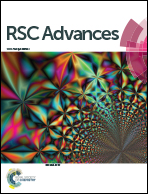Effect of valence states of Ni and Mn on the structural and electrochemical properties of Li1.2NixMn0.8−xO2 cathode materials for lithium-ion batteries
Abstract
Severe capacity fading and voltage decay of Li-rich layered oxides for lithium-ion batteries remain the major bottlenecks to commercialization. Herein, we studied the effect of valence states of Ni and Mn on the structure and electrochemical performances of Li1.2NixMn0.8−xO2. The oxidation states of the transition-metal (TM) were evaluated by X-ray photoelectron spectra (XPS) and validated by cyclic voltammetry (CV). With increasing Mn3+ content, the Li2MnO3 component increases due to less Li loss. The phenomenon of capacity increase upon cycling has been observed owing to the gradual activation of Li2MnO3 caused by the existence of Mn3+. It is worth mentioning that Li1.2Ni0.1Mn0.7O2 reaches the highest discharge capacity value of 231.5 mA h g−1 from the initial value of 76 mA h g−1 after 75 cycles and still keeps 100% of the capacity at 0.1C after 100 cycles. With the increase of Ni3+, Li/Ni mixing decreases because of its smaller size than Ni2+, the content of Li2MnO3 decreases as a result of the decrease of Li and Mn in the TM layers, and the discharge voltage increases on account of the higher reduction potential of Ni4+/Ni3+ compared with Ni4+/Ni2+ and Mn4+/Mn3+. Furthermore, Li1.2Ni0.4Mn0.4O2 delivers a first capacity value of 192.5 mA h g−1 and operating voltage of 3.89 V at 0.1C, and capacity retention of 92.13% and a voltage drop of 0.25 V after 100 cycles, which indicates that the stability of capacity and voltage is improved by a large margin with increasing Ni3+.


 Please wait while we load your content...
Please wait while we load your content...